- Home
- entertainment
- news
- 12 details you might have missed in 'The Hunger Games: The Ballad of Songbirds & Snakes'
12 details you might have missed in 'The Hunger Games: The Ballad of Songbirds & Snakes'
Kirsten Acuna

- Warning: There are spoilers ahead for "The Hunger Games: The Ballad of Songbirds & Snakes."
- We round up callbacks to Suzanne Collins' book and other small details you may have overlooked.
"The Hunger Games: The Ballad of Songbirds & Snakes" contains several nods and callbacks to Suzanne Collins' prequel book of the same name and the franchise at large.
Some of the smaller details may only make sense if you've read the book.
From Lucky Flickerman's evolving fashion to a nod at Katniss Everdeen's weapon of choice in the games, keep reading to see what you may have missed.
A young Coriolanus Snow and Tigris watch their neighbor hack off the limb of a corpse.
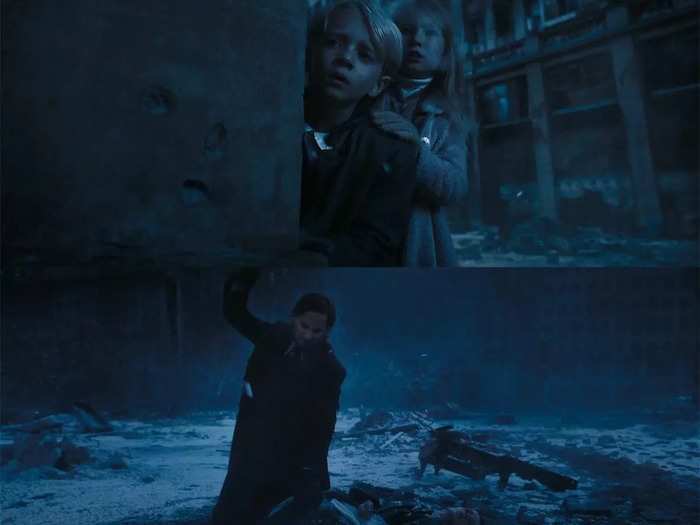
A brief scene in the beginning depicts the "Dark Days" of Panem, a time when the districts pushed back against the tyrannical rule of the Capitol. This first rebellion led to a food shortage in the Capitol, making some resort to cannibalism.
In the book, author Suzanne Collins wrote, "It had been the last year of the war, when the siege had reduced the Capitol to cannibalism and despair. Even the lima beans were running low, and it had been months since anything resembling meat had made its way to their table."
Though the man in the movie seems random, the book reveals this is supposed to be the kids' neighbor, Nero Price, carving away at the leg of a maid before wrapping it in a piece of her torn skirt. Price is also the father of one of Snow's future classmates, Persephone.
Greatly affected by that horrific memory, a teenaged Snow thinks about Price's actions in the book a few times, wondering if Persephone knew the real ingredients of the stew she ate during the war.
Rat poison can be spotted in Coriolanus' bedroom.
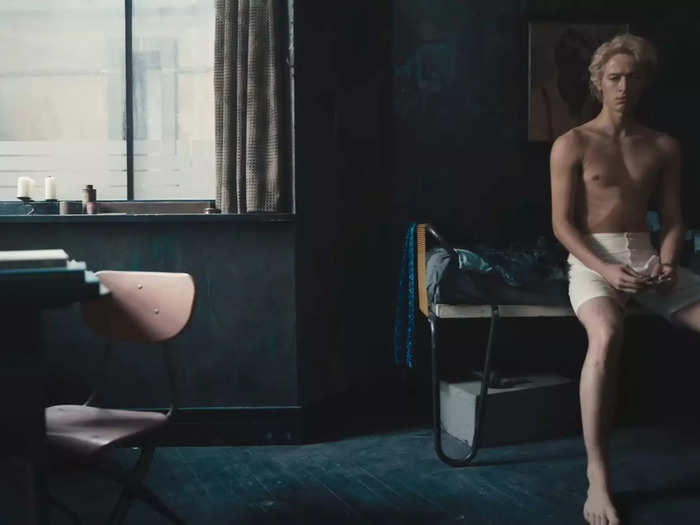
Keep an eye on the belongings in Snow's bedroom. Snow easily provides Lucy Gray with rat poison later in the film because the prequel subtly shows us at the very start that he has access to it in his bedroom.
This also foreshadows Dean Casca Highbottom's demise at the film's end, hinting that Snow is responsible for murdering his former educator.
Coriolanus is likely paired with a District 12 tribute on purpose.
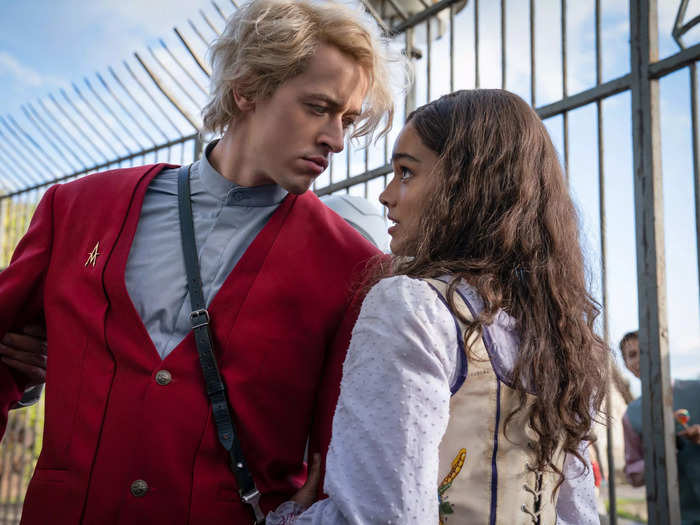
At the beginning of the movie, Dean Casca Highbottom (Peter Dinklage) assigns tributes to the Hunger Games mentors, but they probably aren't random.
Highbottom holds a grudge toward Snow because his father, Crassus, betrayed him years earlier.
Snow's assignment is likely a torturous reminder of his connection to District 12 where his father was killed by a rebel during the war.
Similarly, Sejanus Plinth (Josh Andrés Rivera) is paired with a tribute from District 2, where he used to live. Plinth immediately recognizes the cruelty in his assigned tribute.
Lucy Gray purposefully recreates Katniss Everdeen's iconic curtsy bow.
When Lucy Gray (Rachel Zegler) is selected for the 10th Hunger Games, she gives a little bow, mirroring the one Katniss (Jennifer Lawrence) gives in 2012's "The Hunger Games" during an evaluation.
This is different from the books, where Lucy Gray takes her fellow District 12 tribute's hand and the pair bow together.
"It was actually an improvised moment," director Francis Lawrence told Business Insider. "I came up with the idea on the day for her to do it, to do the curtsy bow."
"We were always looking at any given moment, through the process of making this film, of nodding to the origins of certain things," Lawrence said, adding, "I thought it could be really interesting if Katniss had done it because she's heard that, generations ago, there was a woman who sort of irreverently did this curtsy bow after this performance on stage when she's dragged off to the games. I just liked the idea that Lucy Gray was actually the first one to do it and that there was a history of it."
He added: "It was an improvised thing on the day, wasn't even talked about ahead of time. I think in early takes she wasn't doing it and then I just came up with the idea. I knew the fans would really like it and I thought Rachel would love the idea."
Director Francis Lawrence's face can be spotted on a prominent monument in Snow's school.
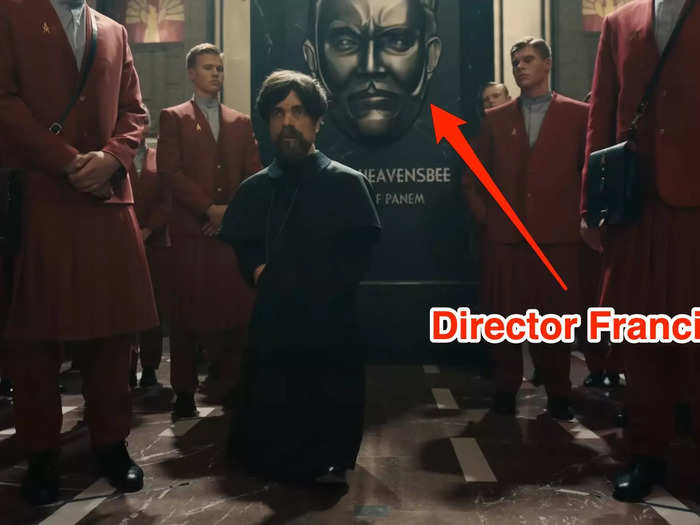
A monument referencing one of Plutarch Heavensbee's ancestors is briefly seen in Snow's school behind Highbottom. Philip Seymour Hoffman appeared in three "Hunger Games" films as the head gamemaker of the 75th annual Hunger Games who aided in a rebellion against Snow.
Lawrence told Business Insider that the statue is self-referential.
"The face is actually me," Lawrence said, adding that he'll usually appear in the movies in some fun way. But he wasn't expecting his Easter egg in "The Ballad of Songbirds & Snakes" to be so visible.
"I thought when the art department was building this thing, it was going to be 12 inches tall or something, this teeny thing," Lawrence said. "I walked on set for the first time when it was dressed, and this face of mine was like four feet tall. I was like, 'Oh my God.'"
"I never wanted to be this featured. I wanted to hide it," he continued. "So if you notice, Peter Dinklage is always kind of blocking it so it's not too clear. But it's my face."
As the Hunger Games progress, Highbottom becomes increasingly sweaty and disheveled.
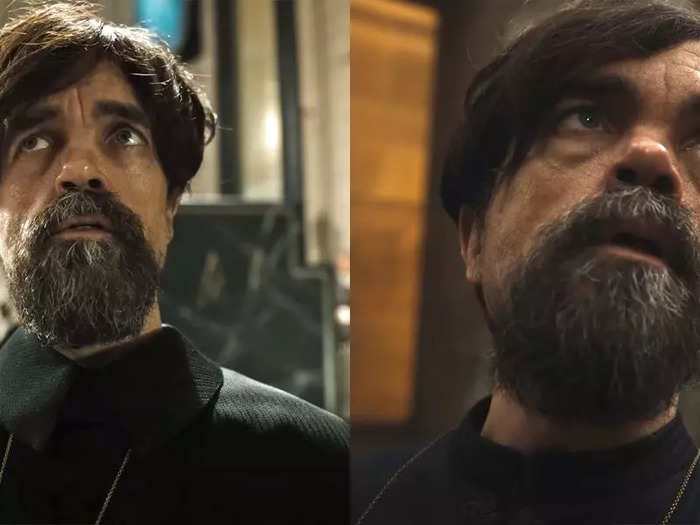
As the tormented creator of the Hunger Games, Highbottom seeks solace in downing morphling, a painkiller meant for severe injuries, throughout the prequel.
According to the production notes, in order to show the drug's physical toll on Highbottom, Lawrence and Dinklage discussed the character's different levels of addiction which the makeup team brought to life.
"Peter was really into the idea of Highbottom having sunken eyes and blotchy red skin tone," said makeup designer Sherri Laurence. "Highbottom gets progressively worse as the Games unfold. Peter was really into making the character look drugged-out."
Lucky Flickerman's appearance and outfits get fancier as his star rises in the Capitol.
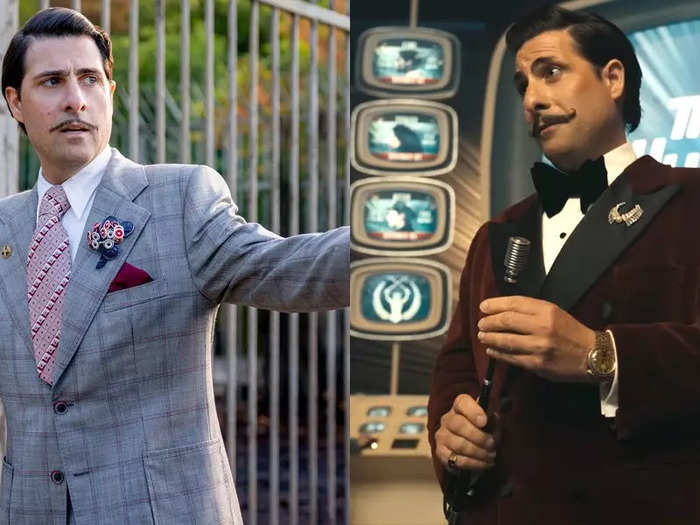
A weatherman and amateur magician, Flickerman is hungry for Capitol fame as the Hunger Games' first broadcast host, and his rise to power can be tracked through his ever-changing mustache and wardrobe.
"As Lucky's work covering the games on television progresses, so does his ego and excitement, so I wanted his hair to start getting a little higher and his mustache to become fancier," costume designer Trish Summerville said in the film's production notes.
Summerville added, "With his wardrobe, it's a slow progression of him dressing fancier and fancier, and by the finale, Lucky's in a tuxedo with tails."
When the tributes enter the arena, they hear the words "Enjoy the show" because it used to be an amphitheater.
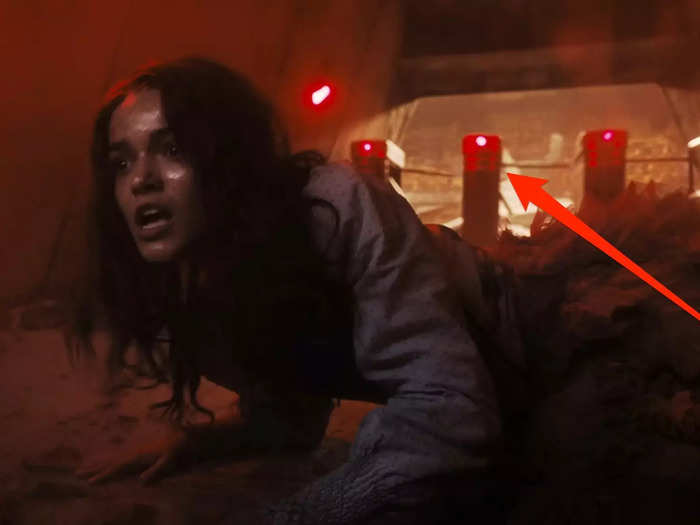
Not mentioned in the movie, the arena was originally home to sporting, entertainment, and military events. When visitors crossed the turnstiles, they'd hear the jovial voice welcoming them into the former amphitheater.
The haunting words hold a darker meaning for the tributes as they become entertainment for the Capitol in their impending fight to the death.
The arena is later targeted by rebel bombers not only because it's the site of the Hunger Games, but because it was also previously used for executions during the war.
Snow spies a bow and arrows when entering the arena to save Sejanus.
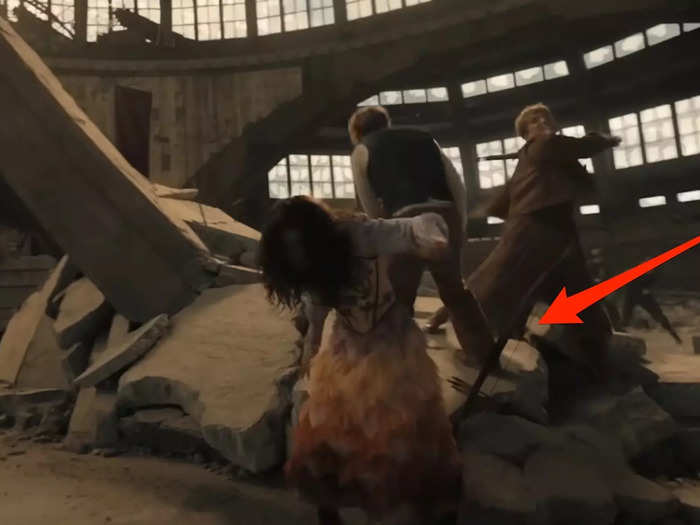
Not only does the sight of it unnerve Snow, but, the production notes reveal that it's also a nod to Katniss Everdeen's future weapon of choice.
Snow and Dr. Gaul wear similar colored outfits that hint at their future working relationship.
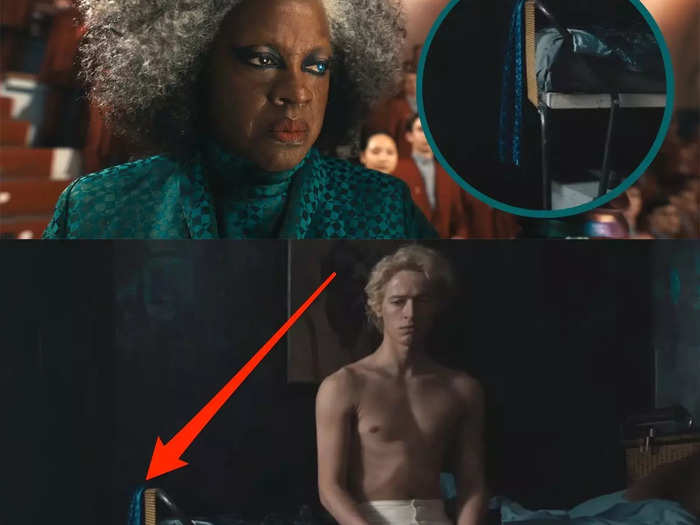
While working on an assignment about making the Hunger Games more accessible to the public, Snow wears a black and turquoise robe.
The robe's colors perfectly match the suit that head gamesmaker Dr. Volumnia Gaul (Viola Davis) wears on the final day of the 10th annual Hunger Games, foreshadowing their future working relationship together and showcasing their alignment on the importance of the games to maintain order and stability in Panem.
Lucy Gray wears Mockingjay feathers in her hair as she performs in District 12, a bird that eventually spells Snow's doom.

Blue feathers can be spotted in Lucy Gray and her cousin Maude Ivory's hair as they perform on stage in District 12.
In the book, Lucy Gray twirls one in her hand while speaking with Snow out on the lake.
The animals are the result of mutated Capitol birds called Jabberjays mating with local mockingbirds. The Jabberjays were modified to record speech and used to spy on Capitol enemies. Never meant to exist, the Mockingjays can similarly repeat melodies and echo a human voice on their own.
Though not addressed in the movie, Snow immediately hates the birds, believing them a stain on the Capitol that never should've existed. Obsessed with order and control, he desires to wipe them all out.
Lucy Gray's association with the songbird highlights her rebellious, free spirit. Like the ever-reproducing Mockingjay, which eventually wipes out the Jabberjay, she's unique and can't be controlled.
The bird causes a headache for Snow decades later when it becomes the symbol of the second rebellion with Katniss embodying the role of the Mockingjay.
Highbottom becomes Snow's first poison victim.
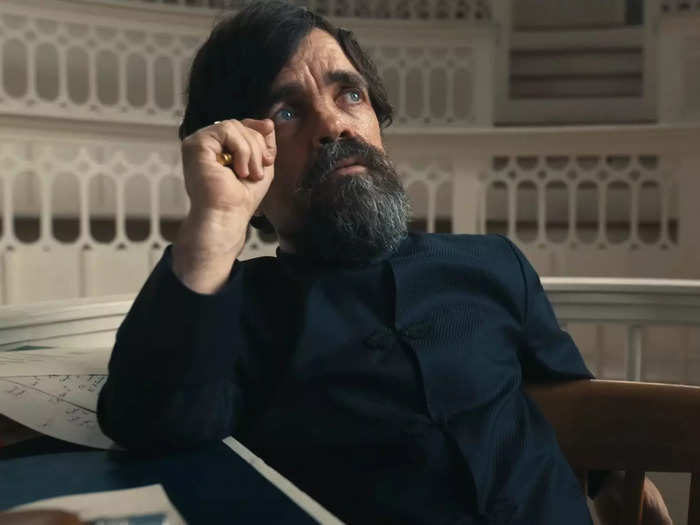
Though it may not be super clear in the movie, Highbottom doesn't die by suicide. The blood running from his nose is supposed to mirror Dill's death earlier in the movie so it's recognizable Highbottom ingested rat poison.
Highbottom's murder isn't solely supposed to be viewed as revenge. On a broader scale, it's supposed to represent Snow's first sneaky use of his murder weapon of choice, poison.
In 2014's "The Hunger Games: Mockingjay — Part I," Finnick Odair (Sam Claflin) reveals President Snow (Donald Sutherland) utilizes poison to kill his enemies and any allies who pose a threat.
Snow memorably forces head gamemaker Seneca Crane to consume poisoned nightlock berries at the end of the first "Hunger Games" movie after Katniss finds a loophole to allow two victors in his game.
Popular Right Now
Popular Keywords
Advertisement